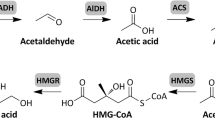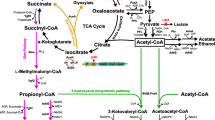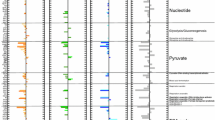Abstract
Crude glycerol obtained as a by-product of biodiesel production is a reliable feedstock with the potential to be converted into reduced chemicals with high yields. It has been previously shown that ethanol is the primary product of glycerol fermentation by Escherichia coli. However, few efforts were made to enhance this conversion by means of the expression of heterologous genes with the potential to improve glycerol transport or metabolism. In this study, a fosmid-based metagenomic library constructed from an anaerobic reactor purge sludge was screened for genetic elements that promote the use and fermentation of crude glycerol by E. coli. One clone was selected based on its improved growth rate on this feedstock. The corresponding fosmid, named G1, was fully sequenced (41 kbp long) and the gene responsible for the observed phenotype was pinpointed by in vitro insertion mutagenesis. Ethanol production from both pure and crude glycerol was evaluated using the parental G1 clone harboring the ethanologenic plasmid pLOI297 or the industrial strain LY180 complemented with G1. In mineral salts media containing 50 % (v/v) pure glycerol, ethanol concentrations increased two-fold on average when G1 was present in the cells reaching up to 20 g/L after 24 h fermentation. Similar fermentation experiments were done using crude instead of pure glycerol. With an initial OD620 of 8.0, final ethanol concentrations after 24 h were much higher reaching 67 and 75 g/L with LY180 cells carrying the control fosmid or the G1 fosmid, respectively. This translates into a specific ethanol production rate of 0.39 g h−1 OD−1 L−1.





Similar content being viewed by others
References
Aakvik T, Lale R, Liles M, Valla S (2011) Metagenomic libraries for functional screening. In: de Bruijn F (ed) Handbook of molecular microbial ecology I, 1st edn. Wiley-Blackwell, Hoboken, New Jersey, pp 171–181. doi:10.1002/9781118010518.ch22
Alterthum F, Ingram LO (1989) Efficient ethanol production from glucose, lactose, and xylose by recombinant Escherichia coli. Appl Environ Microbiol 55:1943–1948
Archer CT, Kim JF, Jeong H, Park JH, Vickers CE, Lee SY, Nielsen LK (2011) The genome sequence of E. coli W (ATCC 9637): comparative genome analysis and an improved genome-scale reconstruction of E. coli. BMC Genom 12:1–20. doi:10.1186/1471-2164-12-9
Beloqui A (2006) Novel polyphenol oxidase mined from a metagenome expression library of bovine rumen: biochemical properties, structural analysis, and phylogenetic relationships. J Biol Chem 281:22933–22942. doi:10.1074/jbc.M600577200
Bendtsen JD, Nielsen H, von Heijne G, Brunak S (2004) Improved prediction of signal peptides: signalP 3.0. J Mol Biol 340:783–795. doi:10.1016/j.jmb.2004.05.028
Bondioli P, Della Bella L (2005) An alternative spectrophotometric method for the determination of free glycerol in biodiesel. Eur J Lipid Sci Technol 107:153–157
Cintolesi A, Clomburg JM, Rigou V, Zygourakis K, Gonzalez R (2012) Quantitative analysis of the fermentative metabolism of glycerol in Escherichia coli. Biotechnol Bioeng 109:187–198. doi:10.1002/bit.23309
Ciriminna R, Pina CD, Rossi M, Pagliaro M (2014) Understanding the glycerol market. Eur J Lipid Sci Technol 116:1432–1439
Clomburg JM, Gonzalez R (2013) Anaerobic fermentation of glycerol: a platform for renewable fuels and chemicals. Trends Biotechnol 31:20–28. doi:10.1016/j.tibtech.2012.10.006
Cofré O, Ramírez M, Gómez JM, Cantero D (2012) Optimization of culture media for ethanol production from glycerol by Escherichia coli. Biomass Bioenergy 37:275–281. doi:10.1016/j.biombioe.2011.12.002
Chaudhary N, Ngadi MO, Simpson BK, Kassama LS (2011) Biosynthesis of ethanol and hydrogen by glycerol fermentation using Escherichia coli. Adv Chem Eng Sci 1:83–89. doi:10.4236/aces.2011.13014
Dharmadi Y, Murarka A, Gonzalez R (2006) Anaerobic fermentation of glycerol by Escherichia coli: a new platform for metabolic engineering. Biotechnol Bioeng 94:821–829. doi:10.1002/bit.21025
Durnin G, Clomburg J, Yeates Z, Alvarez PJ, Zygourakis K, Campbell P, Gonzalez R (2009) Understanding and harnessing the microaerobic metabolism of glycerol in Escherichia coli. Biotechnol Bioeng 103:148–161. doi:10.1002/bit.22246
Ferrer M, Golyshina OV, Chernikova TN, Khachane AN, Reyes-Duarte D, Santos VA, Strompl C, Elborough K, Jarvis G, Neef A, Yakimov MM, Timmis KN, Golyshin PN (2005) Novel hydrolase diversity retrieved from a metagenome library of bovine rumen microflora. Environ Microbiol 7:1996–2010. doi:10.1111/j.1462-2920.2005.00920.x
Finn RD, Clements J, Eddy SR (2011) HMMER web server: interactive sequence similarity searching. Nucl Acids Res 39(suppl 2):W29–W37. doi:10.1093/nar/gkr367
Geddes R, Shanmugam KT, Ingram LO (2015) Combining treatments to improve the fermentation of sugarcane bagasse hydrolysates by ethanologenic Escherichia coli LY180. Bioresour Technol 189:15–22. doi:10.1016/j.biortech.2015.03.141
Gonzalez R, Murarka A, Dharmadi Y, Yazdani SS (2008) A new model for the anaerobic fermentation of glycerol in enteric bacteria: trunk and auxiliary pathways in Escherichia coli. Metab Eng 10:234–245. doi:10.1016/j.ymben.2008.05.001
Handelsman J (2004) Metagenomics: application of genomics to uncultured microorganisms. Microbiol Mol Biol Rev 68:669–685. doi:10.1128/mmbr.68.4.669-685.2004
Hu H, Wood TK (2010) An evolved Escherichia coli strain for producing hydrogen and ethanol from glycerol. Biochem Biophys Res Commun 391:1033–1038. doi:10.1016/j.bbrc.2009.12.013
Jarboe L, Grabar T, Yomano L, Shanmugan K, Ingram L (2007) Development of ethanologenic bacteria. Adv Biochem Engin Biotechnol 108:237–261. doi:10.1007/10_2007_068
Jarboe LR, Grabar TB, Yomano LP, Shanmugan KT, Ingram LO (2007) Development of ethanologenic bacteria. In: Olsson L (ed) Biofuels. Springer, Berlin, Heidelberg, pp 237–261. doi:10.1007/10_2007_068
Johnson DT, Taconi KA (2007) The glycerin glut: options for the value-added conversion of crude glycerol resulting from biodiesel production. Environ Prog 26:338–348. doi:10.1002/ep.10225
Krogh A, Larsson B, Von Heijne G, Sonnhammer EL (2001) Predicting transmembrane protein topology with a hidden Markov model: application to complete genomes. J Mol Biol 305:567–580
Lai E (2014) Biodiesel: environmental friendly alternative to petrodiesel. J Pet Environ Biotechnol 5:e122
Lee SJ, Kim SB, Kang SW, Han SO, Park C, Kim SW (2012) Effect of crude glycerol-derived inhibitors on ethanol production by Enterobacter aerogenes. Bioprocess Biosyst Eng 35:85–92. doi:10.1007/s00449-011-0607-y
Loaces I, Amarelle V, Muñoz-Gutierrez I, Fabiano E, Martinez A, Noya F (2015) Improved ethanol production from biomass by a rumen metagenomic DNA fragment expressed in Escherichia coli MS04 during fermentation. Appl Microbiol Biotechnol 99:9049–9060. doi:10.1007/s00253-015-6801-0
Macrelli S, Mogensen J, Zacchi G (2012) Techno-economic evaluation of 2nd generation bioethanol production from sugar cane bagasse and leaves integrated with the sugar-based ethanol process. Biotechnol Biofuels 5:1–18. doi:10.1186/1754-6834-5-22
Martínez-Gómez K, Flores N, Castañeda HM, Martínez-Batallar G, Hernández-Chávez G, Ramírez OT, Gosset G, Encarnación S, Bolivar F (2012) New insights into Escherichia coli metabolism: carbon scavenging, acetate metabolism and carbon recycling responses during growth on glycerol. Microb Cell Fact 11:46
Matthew S, Wong ML, Black Ryan W, Le Thao Q, Puthli Sharon, Campbell Paul, Monticello Daniel J (2014) Microaerobic conversion of glycerol to ethanol in Escherichia coli. Appl Environ Microbiol 80:3276–3282
Meiswinkel TM, Rittmann D, Lindner SN, Wendisch VF (2013) Crude glycerol-based production of amino acids and putrescine by Corynebacterium glutamicum. Bioresour Technol 145:254–258. doi:10.1016/j.biortech.2013.02.053
Miller EN, Jarboe LR, Yomano LP, York SW, Shanmugam KT, Ingram LO (2009) Silencing of NADPH-dependent oxidoreductase genes (yqhD and dkgA) in furfural-resistant ethanologenic Escherichia coli. Appl Environ Microbiol 75:4315–4323. doi:10.1128/AEM.00567-09
Murarka A, Dharmadi Y, Yazdani SS, Gonzalez R (2008) Fermentative utilization of glycerol by Escherichia coli and its implications for the production of fuels and chemicals. Appl Environ Microbiol 74:1124–1135. doi:10.1128/AEM.02192-07
Nancy YY, Wagner JR, Laird MR, Melli G, Rey S, Lo R, Dao P, Sahinalp SC, Ester M, Foster LJ (2010) PSORTb 3.0: improved protein subcellular localization prediction with refined localization subcategories and predictive capabilities for all prokaryotes. Bioinformatics 26:1608–1615
Nguyen ADQ, Kim YG, Kim SB, Kim CJ (2013) Improved tolerance of recombinant Escherichia coli to the toxicity of crude glycerol by overexpressing trehalose biosynthetic genes (otsBA) for the production of β-carotene. Bioresour Technol 143:531–537. doi:10.1016/j.biortech.2013.06.034
Nielsen H, Engelbrecht J, Brunak S, von Heijne G (1997) Identification of prokaryotic and eukaryotic signal peptides and prediction of their cleavage sites. Protein Eng 10:1–6
Nikel PI, Giordano AM, de Almeida A, Godoy MS, Pettinari MJ (2010) Elimination of d-Lactate synthesis increases poly(3-Hydroxybutyrate) and ethanol synthesis from glycerol and affects cofactor distribution in recombinant Escherichia coli. Appl Environ Microbiol 76:7400–7406. doi:10.1128/aem.02067-10
Nikel PI, Ramirez MC, Pettinari MJ, Méndez BS, Galvagno MA (2010) Ethanol synthesis from glycerol by Escherichia coli redox mutants expressing adhE from Leuconostoc mesenteroides. J Appl Microbiol 109:492–504. doi:10.1111/j.1365-2672.2010.04668.x
Noguchi H, Park J, Takagi T (2006) MetaGene: prokaryotic gene finding from environmental genome shotgun sequences. Nucleic Acids Res 34:5623–5630. doi:10.1093/nar/gkl723
Papanikolaou S, Fick M, Aggelis G (2004) The effect of raw glycerol concentration on the production of 1,3-propanediol by Clostridium butyricum. J Chem Technol Biotechnol 79:1189–1196. doi:10.1002/jctb.1103
Patil KR, Roune L, McHardy AC (2012) The phylopythias web server for taxonomic assignment of metagenome sequences. PLoS One 7:e38581
Punta M, Coggill PC, Eberhardt RY, Mistry J, Tate J, Boursnell C, Pang N, Forslund K, Ceric G, Clements J, Heger A, Holm L, Sonnhammer ELL, Eddy SR, Bateman A, Finn RD (2012) The Pfam protein families database. Nucleic Acids Res 40:D290–D301. doi:10.1093/nar/gkr1065
Purushe J, Fouts DE, Morrison M, White BA, Mackie RI, Coutinho PM, Henrissat B, Nelson KE (2010) Comparative genome analysis of Prevotella ruminicola and Prevotella bryantii: insights into their environmental niche. Microb Ecol 60:721–729. doi:10.1007/s00248-010-9692-8
Rodríguez MC, Loaces I, Amarelle V, Senatore D, Iriarte A, Fabiano E, Noya F (2015) Est10: a novel alkaline esterase isolated from bovine rumen belonging to the new family XV of lipolytic enzymes. PLoS One 10:e0126651. doi:10.1371/journal.pone.0126651
Santero E, Floriano B, Govantes F (2016) Harnessing the power of microbial metabolism. Curr Opin Microbiol 31:63–69. doi:10.1016/j.mib.2016.03.003
Sarma SJ, Brar SK, Sydney EB, Le Bihan Y, Buelna G, Soccol CR (2012) Microbial hydrogen production by bioconversion of crude glycerol: a review. Int J Hydrog Energy 37:6473–6490. doi:10.1016/j.ijhydene.2012.01.050
Sawers R, Blokesch M, Böck A (2004) Anaerobic formate and hydrogen metabolism. EcoSal Plus 2004. doi:10.1128/ecosalplus.3.5.4
Senthilkumar V, Gunasekaran P (2005) Bioethanol production from cellulosic substrates: engineered bacteria and process integration challenges. J Sci Ind Res 64:845–853
Tamura K, Stecher G, Peterson D, Filipski A, Kumar S (2013) MEGA6: molecular evolutionary genetics analysis version 6.0. Mol Biol Evol 30:2725–2729. doi:10.1093/molbev/mst197
Trinh CT, Srienc F (2009) Metabolic engineering of Escherichia coli for efficient conversion of glycerol to ethanol. Appl Environ Microbiol 75:6696–6705. doi:10.1128/aem.00670-09
Valle A, Cabrera G, Cantero D, Bolivar J (2015) Identification of enhanced hydrogen and ethanol Escherichia coli producer strains in a glycerol-based medium by screening in single-knock out mutant collections. Microb Cell Factories 14:93
Valle A, Cabrera G, Muhamadali H, Trivedi DK, Ratray NJW, Goodacre R, Cantero D, Bolivar J (2015) A systematic analysis of TCA Escherichia coli mutants reveals suitable genetic backgrounds for enhanced hydrogen and ethanol production using glycerol as main carbon source. Biotechnol J 10:1750–1761. doi:10.1002/biot.201500005
Wu S, Zhu Z, Fu L, Niu B, Li W (2011) WebMGA: a customizable web server for fast metagenomic sequence analysis. BMC Genom 12:444
Yang F, Hanna MA, Sun R (2012) Value-added uses for crude glycerol–a byproduct of biodiesel production. Biotechnol Biofuels 5:13. doi:10.1186/1754-6834-5-13
Yazdani S, Gonzalez R (2008) Engineering Escherichia coli for the efficient conversion of glycerol to ethanol and co-products. Metabolic Eng 10:340–351. doi:10.1016/j.ymben.2008.08.005
Yazdani SS, Gonzalez R (2007) Anaerobic fermentation of glycerol: a path to economic viability for the biofuels industry. Curr Opini Biotechnol 18:213–219. doi:10.1016/j.copbio.2007.05.002
Yomano L, York S, Ingram L (1998) Isolation and characterization of ethanol-tolerant mutants of Escherichia coli KO11 for fuel ethanol production. J Ind Microbiol Biotechnol 20:132–138
Yu KO, Kim SW, Han SO (2010) Engineering of glycerol utilization pathway for ethanol production by Saccharomyces cerevisiae. Bioresour Technol 101:4157–4161. doi:10.1016/j.biortech.2010.01.066
Zhang X, Shanmugam KT, Ingram LO (2010) Fermentation of glycerol to succinate by metabolically engineered strains of Escherichia coli. Appl Environ Microbiol 76:2397–2401. doi:10.1128/aem.02902-09
Zhang Z, Schwartz S, Wagner L, Miller W (2000) A greedy algorithm for aligning DNA sequences. J Comput Biol 7:203–214. doi:10.1089/10665270050081478
Acknowledgments
We are very grateful to Dr. Lonnie Ingram (University of Florida) for providing pLOI297 plasmid and LY180 strain, as well as to Dr. Liliana Borzacconi (Departamento de Ingeniería de Reactores, Facultad de Ingeniería, Universidad de la República) for providing purge sludges. Special thanks to Nikolai Guchin (ANCAP, Uruguay) and Darío Rodríguez (ALUR, Uruguay) for providing crude glycerol. This work was supported by Grants #FSE_2011_6383 from Agencia Nacional de Investigación e Innovación (ANII, Uruguay), by the Programa de Desarrollo de las Ciencias Básicas (PEDECIBA, Uruguay) and by Sistema Nacional de Investigadores (SNI, Uruguay).
Author information
Authors and Affiliations
Corresponding author
Rights and permissions
About this article
Cite this article
Loaces, I., Rodríguez, C., Amarelle, V. et al. Improved glycerol to ethanol conversion by E. coli using a metagenomic fragment isolated from an anaerobic reactor. J Ind Microbiol Biotechnol 43, 1405–1416 (2016). https://doi.org/10.1007/s10295-016-1818-7
Received:
Accepted:
Published:
Issue Date:
DOI: https://doi.org/10.1007/s10295-016-1818-7




